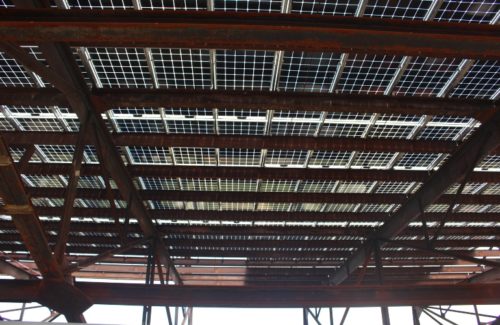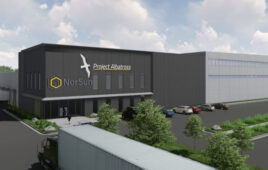Abandoned steel mills are a common sight in the Rust Belt region. Communities formed around these factories as the steel industry boomed, employing thousands of people at a time, but many suffered economic collapse and began shuttering in the 1970s.
These buildings are difficult to redevelop because of their scale and corrosion from years of neglect. But one mill in Pittsburgh, Pennsylvania, is proving it’s possible.
An unlikely partnership formed among public and private foundations, businesses and organizations to reinvigorate Mill 19, an abandoned steel mill built in the Hazelwood neighborhood in 1943 — and photovoltaic solar played an integral role in its redevelopment. The old mill now hosts the largest long-span rooftop solar array in the United States and is an indicator of Pittsburgh’s technological future.
Covering rust with solar
The steel manufactured at Mill 19 was used for munitions production during World War II, and the mill employed about 16,000 people at its peak. Long after the factory shut down in 1998, residents and regional organizations still viewed it as a Pittsburgh landmark.

Mill 19 in Pittsburgh, Pennsylvania hosts the country’s largest long-span rooftop solar array. The former steel mill holds 2 MW of solar panels. Credit: Scalo Solar Solutions
“It was a symbol of pride for all these people,” said Mark Goyke, manager of the special projects division at Scalo Solar Solutions. “You talked to anybody in these [nearby] bars and their old man, or somebody, worked in this steel mill. To keep this building here and then to repurpose it, it’s just a fantastic thing for Pittsburgh, and it really keeps this heritage and legacy of the steel mills open. Even if it’s repurposed, this is ‘New Pittsburgh.’”
Mill 19’s rusted skeletal structure sat untouched for more than a decade. It wasn’t until the 2000s that substantial plans to reinvigorate the 178-acre mill site, called Hazelwood Green, were considered. Regional organizations the Heinz Endowments, the Richard King Mellon Foundation and the Claude Worthington Benedum Foundation formed a coalition called Almono with plans to redevelop Mill 19. Powering it with solar was one of their ideas.
Instead of tearing down the rusted building skeleton, the Regional Industrial Development Corporation (RIDC) built two commercial office buildings within the structure of the mill and has a third building underway. Almono is redeveloping the mill to create a hub for technology-focused businesses and programs.
Almono sought a solar developer at a national scale for this project but went with the local option in Scalo Solar. It took about two years from initial planning before work started on Mill 19’s solar installation.
The scale of this project becomes apparent when driving beside the quarter-mile building. Every possible section of the roof is covered in solar modules except where old exhaust hoods and other steel structures protrude above the roofline. Scalo Solar installed 2 MW of solar on the mill’s skeleton and an additional 500 kW in carports and canopies in parking lots surrounding the mill. The entire solar buildout of Mill 19 was completed in June 2020.
“This had never been done before, so there wasn’t a specification book,” said Jack Scalo, CEO of Scalo Solar Solutions and part of the Scalo Companies. “There wasn’t a design by someone. We really had to figure this out on our own through trial and error.”
Roof access wasn’t easy, and there wasn’t a flat surface atop the mill that installers could stand on either. To add another wrinkle, the RIDC started construction on the first building inside the mill, so there wasn’t viable floor space for scaffolding.
“But as you can see, with all the support structures that are underneath it, you can’t get a lift all the way up there. You can’t get scaffolding without some massive building. The price of scaffolding, which we did actually price out, was more than the rest of the contract,” said Cab Whitaker, senior project manager at Scalo Solar.

Scalo Solar installers were able to work on the roof structure thanks to suspended netting called Spider WorkWebs. Credit: Scalo Solar Solutions
Instead, Scalo Solar commissioned worksite staging company Spider to produce four WorkWebs, suspended netting often used in bridge construction that can be walked on. The WorkWebs were secured in succession at an 80-ft elevation within the mill, and as one section of the array was complete, that netting went up the line.
“They were building a three-story building underneath this existing steel structure and putting solar on top of that, so it’s unprecedented,” said Jesse Ament, marketing director for Scalo Solar Solutions.
Since it was such a distance to the roof, installers set up a staging area on the ground where they assembled panels into groups of nine at a time. Those modules were then hoisted by a 150-ton crane and placed atop the mill instead of taken up one panel at a time. As one crew was assembling, another was installing.
Due to construction of a road along the front of the mill, Scalo was forced to hoist modules from the backside of the building — where the crane operator could not see through or over the sloped roof. Installers radioed the crane operator and guided the modules into place. This was done along the entire quarter-mile length of Mill 19.
Another challenge on this project was a requirement that installers secured the array on the mill without drilling into the steel structure since it is a historic structure. The modules are held in place using custom-designed racking with brackets and straps coming down the structure that are, at most, welded to it.
“So, 4,968 panels, all mounted, not one drill hole,” Whitaker said.
There’s an SMA Sunny Tripower Core inverter on nearly every other column of the mill. In conjunction with those are breaker panels that feed to the inverter and act as combiner boxes.
The project uses LG 390-W bifacial modules, not for the additional backside generation — Whitaker said there’s close to none anyway — but for their aesthetics. Having no backsheets means more light passes through a module, casting more natural light onto the buildings housed inside the mill.
The array atop Mill 19 meets all of the facility’s current energy needs and will easily cover the power needs of the third office building, Whitaker said. The carports and canopies are also bonus production.
Reinvigorating Hazelwood Green
Redeveloping Mill 19 and the entire Hazelwood Green site was possible thanks to both grants and creative use of the investment tax credit. Both RK Mellon and Scalo Solar invested in the project and formed a public-private partnership that resulted in the Mill array and additional carports and canopies. Without that collaboration, Mill 19’s solar output wouldn’t be at this scale.

Scalo Solar installed bifacial solar modules atop the mill without drilling into the structure. While they don’t provide that much backside generation, the bifacial modules let more natural light into the mill. Credit: Billy Ludt/Solar Power World
However, the entire solar project wouldn’t have been possible without one person: Michael Carnahan.
“Mike was the engine behind this project in terms of figuring it all out in terms of design logistics. This unfortunately proved to be Mike’s swan song, but Mike was absolutely critical to this project and I doubt that anyone else in the City of Pittsburgh could have executed this project besides Mike,” Scalo said.
Carnahan was general manager at Scalo Solar and had been with the company since 2011. He died in January, several months after Mill 19 was completed.
“This was an iconic project. It’s our flagship and it’s Mike’s iconic project and Mike’s flagship,” Scalo said. “He really believed in renewables and in solar. He was passionate about what he did and again firmly believed in it as a way of life.”
While parts of Mill 19 and Hazelwood Green are still under development, the site is already looking renewed. Two modern office buildings are completed and housed in the frame of Mill 19, with the third under construction. Current tenants include Carnegie Mellon University’s Advanced Robotics Manufacturing Institute and Manufacturing Futures Initiative. And above it all rests 2 MW of bifacial solar modules.
“Ultimately, the promise of solar is future jobs. It’s industry. It’s taking that legacy of coal and mill and turning it into solar now,” said Leo Kowalski, consulting program director with the Pennsylvania Solar Center. “There’s sales jobs, there’s technical work, there’s high-level engineering, there’s business management. There’s a ton of opportunity that solar creates and this is such a visual example of that. It’s housing all this new industry and solar is tied to all of it.”





Great use for old structures. A new system coming on the market does employ a bifacial panel and a monofacial in a package with galv. steel. This offers a very long lasting solar and weatherproof covering for any structure needing a permanent roof. Can also be installed with bearings at 24″ O.C. by roofers.
“The project uses LG 390-W bifacial modules, not for the additional backside generation — Whitaker said there’s close to none anyway — but for their aesthetics. Having no backsheets means more light passes through a module, casting more natural light onto the buildings housed inside the mill.”
I would submit the bifacial modules would be a good addition of something like this “framework” if you wanted to repurpose the (entire space) into a very large vertical hydroponics facility. Re-dress a dinosaur and use if for another purpose, now what could we do with the several large cooling tubes for nuclear plants that didn’t get finished? Monoliths waiting for another purpose, multi level living, apartments, multi level businesses a waste water treatment plant on the top floor and clean potable water at the bottom floor. Actual living quarters, businesses somewhere between the bottom floor and middle floors.